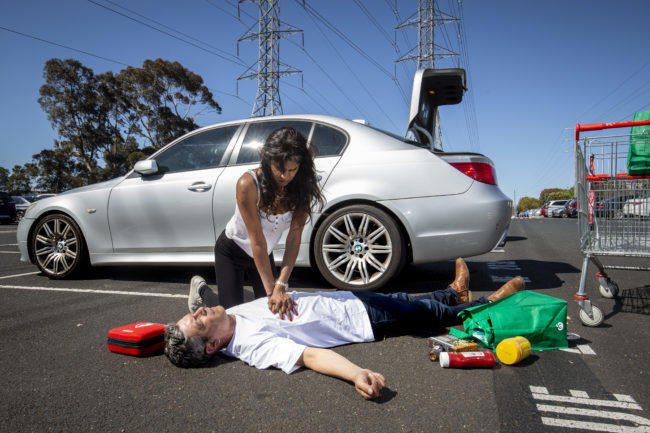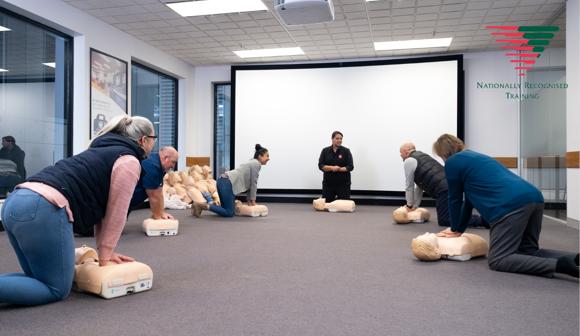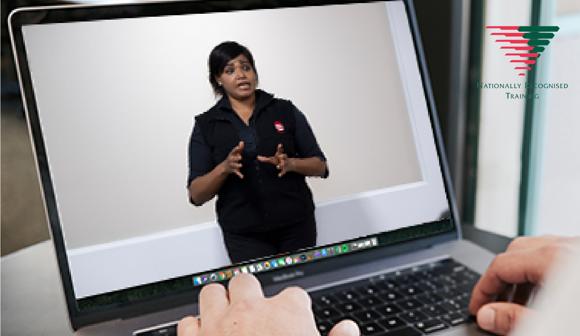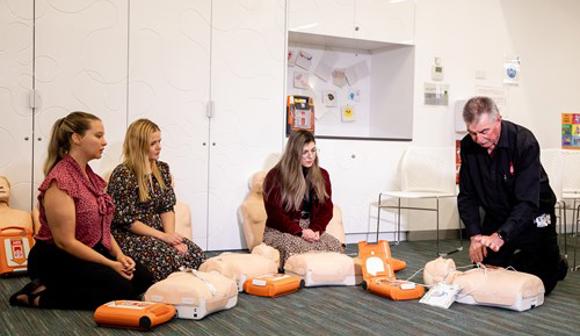How to Stay Calm in an Emergency Situation

Whether it’s a stranger, a colleague or a loved one facing an emergency medical situation, it can be a highly stressful and traumatic event. While you may think you know what to do in these scenarios, a sudden medical emergency may leave you feeling overwhelmed. Luckily, there are things you can do to stay calm and collected in an emergency medical situation to give the patient the best possible chance at survival.

Why do we panic in certain situations?
In frightening and stressful situations, our body moves into survival mode or ‘Fight-or-flight syndrome’. Fight-or-flight syndrome is an evolutionary response to danger which, as its name suggests, primes the body to fight or flee from a would-be threat. This involves a large release of both adrenaline and the stress hormone cortisol into the bloodstream.
You are likely familiar with how fight-or-flight syndrome feels. The heart races and breathing becomes more rapid. Pupils dilate and senses become razor-sharp. Energy levels spike as nutrients flood the bloodstream and extra oxygen is sent to the brain, putting it on high alert. However, this process also involves a partial shutdown of the pre-frontal cortex – the area of the brain responsible for higher functions like critical thinking and memory. This is the reason many describe a feeling of being on ‘autopilot’ when they recall traumatic memories.
Unfortunately, whilst the fight-or-flight response is great for surviving an encounter with a hungry tiger, it can make responding to a medical emergency difficult. Stress-reduction techniques and up to date first aid knowledge can, therefore, make a real difference.
Does the situation require an ambulance?
If someone is seriously injured and in need of urgent medical help, or you have witnessed a serious incident, it’s important to call 000 and ask for an ambulance immediately. If you are calling from a mobile phone you might be asked from which state you are calling.
If you’re prone to panicking in high-stress situations, being aware of what the operator needs to know can be of great help. You will be asked the location of the emergency, and basic questions about the nature of the incident and the patient’s condition. You may also be given certain simple instructions that will help the patient and paramedics when they arrive.
It’s important that you stay on the line and answer the call taker’s questions as clearly as possible. Be mindful that when stressed you may find yourself raising your voice or mumbling your words. Try your best to speak with a deliberate, slow pace.
You might find yourself tempted to blurt out information quickly because you’re worried about the patient, but remember, an ambulance has already been dispatched. The best way to help the patient is to speak slowly and make sure the call taker understands what you are saying.

How to stay calm during an emergency?
Try deep breathing – As described above, fight-or-flight syndrome will increase your heart rate and quicken your breathing. If you find yourself overwhelmed in an emergency and perhaps unable to apply first aid or communicate with the ambulance dispatcher, deep breathing techniques may help.
Attempt to inhale deeply, expanding your diaphragm. After 3 seconds or so, pause, then exhale just as slowly. After a moment you’ll likely begin to relax.
Practise mindfulness – Mindfulness techniques can not only help you relax and reduce stress in day-to-day life, they can also help you calm down in an emergency. Notice and acknowledge that the physical responses you are experiencing are temporary and merely a result of fight-or-flight syndrome. The mere acknowledgment of this fact may calm you down enough to tackle the situation.
Repeat a mantra – Some find internally repeating a simple phrase or mantra in a stressful situation helpful. A reassuring phrase such as ‘it will be okay’, or even a single word like ‘calm’ may be enough to ground yourself and relax.
Undertake first aid training – First aid training equips you with key skills you need to address a variety of medical situations. Having this know-how can give you the confidence and composure to more effectively tackle emergencies when the need arises.

Recognising common emergency scenarios
Each year thousands of Australians will experience a stroke, heart attack, or cardiac arrest. Together, these afflictions are responsible for around 30% of deaths in Australia.
Alarmingly, many Australians report not being aware of the signs and symptoms of these conditions. At times, the symptoms of these conditions can overlap, and therefore it is especially important to learn about the characteristics of each.

Stroke
Each year over 50 000 Australians experience a stroke, and roughly 10 000 die as a result. The majority of stroke victims are older; 70% are over the age of 65. However, strokes can sometimes affect younger people too.
There are two kinds of stroke. Ischaemic strokes occur when blood vessels in the brain become blocked by either plaque or a blood clot. Haemorrhagic strokes occur when blood vessels leak or break. In both cases oxygen and essential nutrients are prevented from reaching brain cells, resulting in a serious medical emergency.
If you suspect someone is having a stroke, you can use the FAST test.
Face: Check their face. A common sign of stroke is a drooping mouth, often on just the one side of their face.
Arms: Ask them to raise their arms. If they have difficulty raising one arm, this is a possible sign of stroke.
Speech: Have them speak to you. If they’re having trouble speaking, slurring their words, or they do not understand what you’re saying to them, this is too is a sign of stroke.
Time: If any of these signs are present, call an ambulance immediately. It is crucial that a stroke-victim receives medical treatment as soon as possible.
While waiting for an ambulance, be aware that a stroke-victim may fall unconscious and stop breathing. If this occurs, you may need to start CPR. An ambulance call taker can instruct you in this process, however, taking a basic first aid/CPR course can better prepare you to take action if a family member, colleague, or stranger has a stroke.

Heart attack
Heart attacks are roughly as common as strokes, affecting over 50 000 Australians every year. Like strokes, they are more common in older age groups, but can still affect younger individuals – especially those with underlying heart conditions.
Much like strokes, heart attacks involve the blockage of an artery supplying oxygen and nutrients to the heart muscle. When cut off from oxygen and nutrients, sections of heart muscle will begin to die. The longer a heart attack victim goes without medical attention, the greater the risk of serious, long-term heart damage. This means rapid medical attention is of paramount importance.
Heart attacks can prompt several varied symptoms that can range from mild to severe. Some of the key signs include:
- Tightness, pressure, or pain in the chest region.
- Shortness of breath
- Dizziness or light-headedness
- Nausea, and pale, cold & clammy skin
- Females commonly may not experience chest pain
- Tingling, aching, or a feeling of heaviness in one or both arms and shoulders. Heaviness in the arms is also a common symptom of stroke, so you may need to look to other symptoms to indicate which condition someone is experiencing.
Typically, a heart attack victim will remain conscious and breathing, and will be able to call an ambulance for themselves. However, as the symptoms are often comparatively mild, a victim may shrug them off and avoid seeking medical attention. If they describe any of the above symptoms as lasting for more than 10 minutes, you should call 000. If unsure, assume it could be a heart attack, and call 000.

Cardiac Arrest
Roughly 20 000 Australians experience cardiac arrest annually, and whilst most heart attack and stroke victims will survive the event, only 10% of cardiac arrest victims live to talk about it.
Unlike the blockages and bleeding associated with a heart attack and stroke, a cardiac arrest is an electrical problem of the heart. The rhythm of a healthy heart is moderated by electrical signals, which if disrupted can stop it from pumping. This prevents blood, and the oxygen it carries, from reaching the body’s vital organs including the brain.
A cardiac arrest victim will lose consciousness and stop breathing almost immediately, making it easy to identify. An ambulance should always be called immediately, as every minute that goes by without treatment dramatically reduces the chance of survival. Defibrillation, if available, can drastically improve survival rates, which is why having them installed in offices, sporting clubs and other public spaces can save lives.
Medical emergency situations can be a highly stressful situation and sometimes even remembering the smallest things like the triple 000 number can be forgotten. Therefore, to alleviate heightening an already stressful situation, it’s encouraged that people download the Emergency + app. The app uses a mobile phone’s GPS functionality so callers can provide emergency call-takers with their location information as determined by their smartphone.
Remember, if you suspect someone is having a heart attack, stroke, or cardiac arrest or any other serious medical crisis, call 000 immediately while CPR is commenced without delay. A defibrillator should be applied immediately if possible.

PROVIDE FIRST AID
Learn how to manage a range of common first aid scenarios.

MENTAL HEALTH AND CRISIS SUPPORT
Learn how to recognise and support people dealing with a range of common mental health issues.

PROVIDE CARDIOPULMONARY RESUSCITATION
Learn the skills to perform life-saving (CPR) on an adult, child or infant who is unconscious and not breathing normally.
